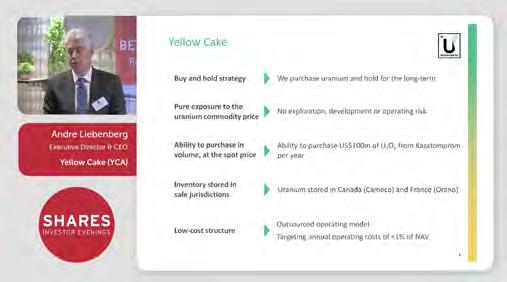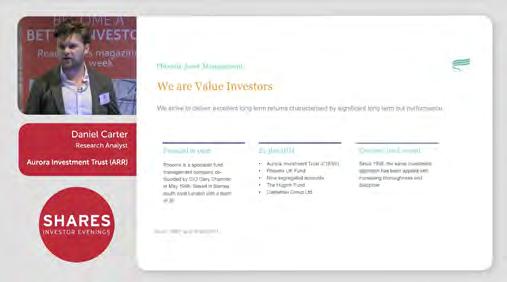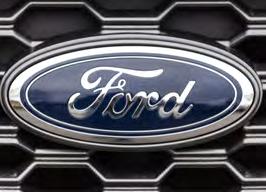
VOL 25 / ISSUE 22 / 08 JUNE 2023 / £4.49 The next generation of Discover the challengers rivalling Tesla







• Investors look for soft landing again after debt ceiling deal and jobs report
• WE Soda plans first big float in London of 2023 with retail investor offer
• A quarter of the FTSE 100 and 30% of the FTSE 250 offer dividend yields of 5% or more



• The utilities supplier enjoying significant share price gains

• Worrying signs for discounter Dollar General as it cuts its forecasts
16


08 June 2023 | SHARES | 03 Contents 06 NEWS
13 GREAT IDEAS New:
Updates:
Haleon / Schroder Global Equity
ME Group International
FEATURE
FEATURE The
FEATURE
to
FEATURE Investing on a budget: these simple
build wealth in no
36 INVESTMENT TRUSTS Big discounts on investment trusts can
40 EDITOR’S VIEW The stock market might punish AI losers faster than it bids up potential winners 41 CASE STUDY Frustrated by paltry interest rates Anne-Marie decided to turn to the markets 44 DANI HEWSON How robotics and AI might shake up the labour market 46 ASK TOM Should I draw down from a pension and reinvest the money in an ISA? 47 PERSONAL FINANCE Is now a good time to buy an annuity? 49 INDEX Shares, funds, ETFs and investment trusts in this issue 32 XX 41 21 06 16 36
Transformers vs Barbie: How Hasbro and Mattel make big money from their intellectual property 21
next generation of electric vehicles: Discover the challengers rivalling Tesla 28
What will it take for ESG investing
come back into favour? 32
steps could help you
time
sometimes but not always mean great bargains
Three important things in this week’s magazine 1 2 3

The next generation of electric vehicles
Running the rule over the stocks aiming to rival Tesla in this fast-growing market.


Investing on a budget

You don’t need lots of spare cash to benefit from putting money into the markets as Shares explains.
Visit our website for more articles
Did you know that we publish daily news stories on our website as bonus content? These articles do not appear in the magazine so make sure you keep abreast of market activities by visiting our website on a regular basis.


Over the past week we’ve written a variety of news stories online that do not appear in this magazine, including:
Mattel vs Hasbro
How the makers of Barbie and Transformers stack up ahead of two big film releases aimed at bolstering the toys’ appeal.
increases

04 | SHARES | 08 June 2023 Contents
ASOS shares rise 10% as speculation over Turkish rival takeover
Shares in specialist mortgage lender Paragon jump 8% as increased full year guidance pleases
Why Citi analysts are getting excited about Ford
Dechra Pharmaceuticals shares rise as board agrees takeover bid









































































Investing in Robotics & Arti cial Intelligence? Put automation to work in your portfolio. Robotics & Arti cial Intelligence UCITS ETF BOTZ LN GLOBALXETFS.EU @GLOBALXETF sEU Beyond Ordinary ETFs™ Issued by Global X Management Company (UK) Limited, 123 Buckingham Palace Road, London, SW1W 9SH, which is authorised and regulated in the UK by the Financial Conduct Authority. Information about us can be found on the Financial Services Register (register number 965081). This communication has been approved as a financial promotion, for the purposes of section 21 of the Financial Services Market Act 2000 (FSMA), by Resolution Compliance Limited which is authorised and regulated by the Financial Conduct Authority (FRN:574048). Capital at risk: The value of an investment in ETFs may go down as well as up and past performance is not a reliable indicator of future performance. Prospectuses and Key Investor Information Documents (KIIDs) for these ETFs are available in English at www.globalxetfs.eu.
Investors look for soft landing again after debt ceiling deal and jobs report
There is a growing belief the Fed can slow the economy and bring inflation down without causing a deep recession
Off the back of a breakthrough on the US debt ceiling, there was further evidence of a robust US labour market as May non-farm payrolls came in much stronger than expected. The economy added 339,000 jobs compared with a 195,000 forecast by economists (2 June).

The prior two months figures were also revised upwards. Job gains were strong across the board including more cyclical parts of the economy such as construction and leisure and hospitality.
This might have been expected to be taken negatively by the markets, given the potential implications for interest rates.
After all, the reading suggests higher rates are not yet having a big impact on economic growth. While this is problematic for the Federal Reserve which sees a resilient jobs market as a driver of sticky inflation, investors seem to be placing more weight on increasing odds of a soft-landing scenario.
They can point to rising unemployment which edged up to 3.7% from 3.4% in May and cooler wage inflation which fell to an annual rate of 4.3%.
With nine days to go until the Fed’s next interest rate meeting decision the odds have shifted once again. According to the CME FedWatch Tool investors believe there is an 82% chance the Fed will pause in June, up from just over a third last week.
However, the chance of a quarter percentage point increase in July has increased to 53%, while there is an outside 11% chance of a half a percentage point increase. Meanwhile US 10-year treasury yields have increased to 3.7% from 3.6% before the May jobs report.
Ahead of the latest jobs numbers, it always felt inevitable negotiations between the White House and the Republicans over raising the US debt ceiling would go to the wire.
Treasury secretary Janet Yellen pinned the so-
called x-day when the US would run out of money as 1 June (before offering an extension to 5 June) and sure enough that was when a deal was finally agreed after weeks of political wrangling.
The agreement forestalls potential financial Armageddon caused by the world’s largest economy formally defaulting on its debts.
The premium on US five-year sovereign credit default swaps which pay out if a default occurs rose substantially ahead of the agreement, from 0.2% a year ago to 0.66% in the middle of May.
The deal suspends the $31.4 trillion borrowing limit until 2025, setting caps on spending and putting restrictions on fiscal policy until after next year’s election.
Credit rating agency Fitch maintained its negative watch on the US until the Autumn while it considers the ‘coherence and credibility’ of policy making and medium-term debt trajectories. [MG]
News 06 | SHARES | 08 June 2023
29 May 3101 Jun 03 05 4,200 $4,250 S&P 500 Chart:
US stocks rally after debt ceiling deal and jobs numbers
Shares magazine • Source: Refinitiv
WE Soda plans first big float in London of 2023 with retail investor offer
Multi-billion industrial chemicals listing set to land on the UK market
The London stock market is set to be bolstered by its first new company listing of scale in some time if WE Soda gets its proposed IPO (initial public offering) away. Interestingly, the company plans to offer retail investors an opportunity to get in on the ground floor through the PrimaryBid platform.
Despite its name, the company has nothing to do with fizzy pop, it is instead a speciality chemicals business and the world’s number one producer of natural soda ash. Soda ash is derived from a mineral called trona and has a multitude of industrial uses from the production of glass and detergents to pharmaceuticals and food.
Operating two facilities in Turkey, WE Soda produces more than five million tonnes of soda ash every year, sold to more than 100 industrial customers in 80-odd countries. It hopes to raise
is soda ash used for?

new capital to repay loans owed to Turkish parent Ciner Group, reduce debt and assist funding plans for a $5 billion production upgrade by 2030, which would more than double its current output.
‘WE Soda is an extraordinary business supplying essential products to support the energy transition’, says chief executive Alasdair Warren.
The principal shareholder in the company is currently Turkish media mogul Turgay Ciner and he is expected to retain a holding equivalent to two thirds of the business following the IPO.
WE Soda hopes to list its shares on the premium segment of the London market with a minimum free float of 10% of the business, with various reports pitching a market valuation of between $7.5 billion to $8.5 billion (£6 billion to £6.85 billion). This could make it eligible for inclusion in some FTSE UK indices.
London listings have dried up dramatically over the past 18-months, leaving investors with little more than scraps to feed on. According to consultancy EY, in the first three months of 2021 the UK stock market saw just five issues raising a paltry £81 million. In 2022 just £1.6 billion was raised, less than 10% of the £1.6 billion raised the previous year.
It is too soon to call a turn of the tide but there have been glimmers of IPO interest. For example, US hedge fund Mudrick Capital is eyeing a £300 million capital raise to list an investment trust that, according to reports, would invest in distressed credit in the US. Fund services minnow Amicorp has also announced its intention to float, while fintech investment firm Ashington Innovations (ASHI) listed on 6 June. [SF]
News 08 June 2023 | SHARES | 07
Flat glass (30%) Container glass (18%) Chemicals (14%) Powdered soap and detergents (9%) Solar panels (5%) Lithium carbonate (1%) Other (23%) 30% 18% 14% 9% 5% 23% Chart: Shares magazine • Source: WE Soda, October 2022
What
A quarter of the FTSE 100 and 30% of the FTSE 250 offer dividend yields of
5% or more
Returns from cash increasing but generous income forecast from UK stocks
While the rates of interest available on cash savings accounts have increased significantly of late, research carried out by Shares shows a quarter of the FTSE 100 and 30% of the FTSE 250 offer dividend yields of more than 5%.
You can get a 5% rate from cash on deposit but it typically involves putting your money away for at least one year. Unlike cash, stocks have the potential for capital gains (though also the risk of loss too).
But before you get carried away, a high dividend yield needs careful examination as it can be a sign the market thinks the dividend is at risk of being cut or cancelled.
The top yielders on the FTSE 100 are mainly drawn from the ranks of the financial sector. While this space is benefiting from higher interest rates, banks, specifically, are exposed to risks of
Top yielding FTSE 100 firms
increasing bad debts among their customers – both businesses and individuals. However, most banks remain optimistic about their prospects for the short and longer-term. For example, HSBC (HSBA) yields 7.6% and said in May that it should soon pay as much in dividends as it did pre-pandemic.
The mining sector is also heavily represented; Glencore (GLEN) and Rio Tinto’s (RIO) respective yields of 11% and 7.4% are generous but one needs to recognise their share prices have been weak this year on fears about the global economy and nearterm commodities demand.
Top yielding FTSE 250 firms
The FTSE 250 list of highest-yielding stocks is more of a mixed bunch.
Infrastructure firms are sensitive to shifts in interest rate expectations, which explains why many companies in this space have been weak on the stock market of late as rates are expected to go up again soon. However, they are traditionally seen as good sources of income.
Digital 9 Infrastructure (DGI9) offers an 11% prospective dividend but this is not currently covered by operating cash, which explains why investors are worried the current level of payout is unsustainable. [TS]
News 08 | SHARES | 08 June 2023
Glencore 11.0% M&G 9.9% British American Tobacco 9.4% Phoenix 9.4% Vodafone 9.3% Legal & General 8.7% Imperial Brands 8.4% Aviva 8.3% Taylor Wimpey 7.9% HSBC Holdings 7.6% Company Dividend yield (%) Table: Shares magazine • Source: SharePad,
at 6 June 2023
data as
Ithaca Energy 18.5% Diversified Energy Company 16.0% Digital 9 Infrastructure 11.4% Liontrust Asset Management 9.0% Energean 8.9% Bank of Georgia 8.8% Sequoia Economic Infrastructure Income Fund 8.5% GCP Infrastructure Investments 8.4% Company Dividend yield (%) Table:
Shares magazine • Source: SharePad, data as at 6 June 2023
The utilities supplier enjoying significant share price gains

Independent gas, electricity and water firm Yu Group is demonstrating significant momentum
Shares in gas, electricity and water supplier Yu Group (YU.:AIM) have soared off the back of its latest profit upgrade (31 May). The shares gained more than a third in the wake of the announcement to 676p, extending gains over the last six months to nearly 70%.
The company, which endured a big sell-off in 2018 thanks to accounting issues, aims to provide a one-stop-shop utilities service for UK small and mediumsized enterprises.
Yu reported that the run-rate of average monthly bookings seen in the fourth quarter of 2022 has continued into 2023. This has been supported by pent-up demand from falling energy prices and has increased visibility on future revenue.
Investment in its ‘Digital by Default’ strategy and in smart meters has helped reduce levels of bad debt and driven strong cash generation such that revenue,
Worrying signs for discounter Dollar General as it cuts its forecasts
Poundland equivalent is S&P 500’s second worst weekly performer after 22% plunge
US consumers have been pretty robustly spending this year despite higher interest rates, yet they don’t seem to be shopping at discounters, which seems odd.
Dollar General (DG:NYSE), whose core customer base is lower-income, cut its outlook on 1 June after admitting the economy was ‘more challenging than we had previously anticipated’ and was having ‘a significant impact on customers’ spending levels and behaviours’.
Dollar General is the equivalent of the UK’s Poundland, selling lots

of everyday items for a dollar, so if shoppers aren’t switching in its favour after months of persistent inflation you might wonder why. Investors certainly are, sending the shares plunging 22% to make it the second worst S&P 500 performer over the week ended 2 June.
Nearly a third of US adults reported they were either ‘just getting by’ or ‘finding it difficult to get by’, according to a survey taken in late 2022 and recently released by the Federal Reserve. [SF]
margins and cash flow for 2023 are expected to be ‘substantially’ ahead of expectations.
Broker SP Angel lifted its revenue forecasts for 2023 and 2024 by 17.1% and 10.2% respectively to £392.4 million and £447.3 million and notes the company is on track to achieve its target of £500 million in revenue by the end of 2025. [TS]
News 08 June 2023 | SHARES | 09
HIGHER Moving DOWN in the dumps Dollar General ($) Dec 2022 Jan 2023 Feb MarApr May Jun 160 180 200 220 240 Chart: Shares magazine • Source: Refinitiv Yu Group (p) Dec 2022 Jan 2023 Feb MarApr May Jun 400 600 Chart: Shares magazine • Source: Refinitiv
UK UPDATES OVER THE NEXT 7 DAYS
Will Ashtead continue to benefit from a US infrastructure boom?
US-focused construction equipment hire group Ashtead (AHT) is set to report its full-year results on 13 June with investors hoping for its recent strong performance to be sustained.

FULL-YEAR RESULTS
June 9: Industrials Reit
June 13: Oxford Instruments, Tatton Asset Management, Iomart, Mind Gym, BP Marsh & Partners
June 14: Ashtead, Castings, Motorpoint, Marks Electrical, Severfield, Eckoh
June 15: Molten Ventures, Halma, Halfords, Syncona Limited, Norcros

HALF-YEAR RESULTS
June 13: Atrato Onsite Energy, Driver, Hamak Gold
June 14: Safestore Holdings
In its third-quarter trading update in March, the company described its end-markets as ‘robust with ongoing momentum’ and said it expected its full year results to be ahead of previous expectations.
Third-quarter revenue was up 23%, leading to a 25% rise in nine-month turnover to $7.2 billion and a 36% increase in underlying EPS (earnings per share) over the same timeframe to $2.89. This was thanks to higher
rental rates and a higher level of fleet utilisation.
With the business clearly receiving a lift from federal and state-funded infrastructure projects, and a notable improvement in its specialty hire business, analysts duly raised their forecasts for the year to 30 April to $9.7 billion of sales and EPS of $3.80.
The shares have had a nice run of late, so a certain amount of good news is already baked into the current price, but Ashtead has a habit of beating forecasts as it continues to grow market share both organically and through bolt-on acquisitions.

As it grows, so it benefits from greater economies of scale meaning margins and returns on capital employed edge up, which in turn allows it to invest in the business and at the same time return capital through share buybacks and dividends. [IC]
TRADING ANNOUNCEMENTS
June 13: Bellway
June 15: Fuller, Smith & Turner

News: Week Ahead 10 | SHARES | 08 June 2023
Tool hire firm reported its end-markets were ‘robust with ongoing momentum’ in March What the market expects of Ashtead April 2023 forecast $3.809.72 April 2024 forecast $4.3210.89 EPS ($) Revenue ($bn) Table: Shares magazine • Source: Stockopedia
Can Adobe live up to its emerging AI hype?

They’ll be plenty for investors to watch when Adobe (ADBE:NASDAQ) unloads its latest quarterly results next week (15 June), with AI (artificial intelligence) excitement having lit a fire under the share price in recent weeks.

The stock has added roughly 30% since the middle of May with investors seeing the creative design software giant as a major longrun AI winner, but there are more immediate matters to focus on too, not least the regulatory rabbit hole that its proposed $20 billion
acquisition of Figma seems to have disappeared down.
When forecast-busting first quarter earnings were posted (15 March) investors took the view that a growth miss late last year was a blip rather than something more harmful. We’ll see. Adobe had steered investors to expect EPS (earnings per share) in the range of $3.75 to $3.80 on an adjusted basis on $4.75 billion to $4.78 billion in revenue for the second quarter, and analysts have nudged estimates towards the top of that range over past weeks.

Adobe chairman and CEO Shantanu Narayen has previously singled out Adobe’s Creative Cloud, Document Cloud and Experience Cloud offerings as ‘mission-critical in fuelling the global digital economy’, and we would expect him to reaffirm those claims this time round, with a healthy sprinkling of AI terminology used in commentary. [SF]
June
June
June
News: Week Ahead 08 June 2023 | SHARES | 11
Creative design software giant has been on a rip as investors look for long-run upside US
THE
QUARTERLY RESULTS
UPDATES OVER
NEXT 7 DAYS
9:
NIO, Tatneft
12:
13:
Uranium Energy, Eaton Vance June
Braze
14:
Renew Energy Global, Oxford Industries, Planet Labs
& Sons What the market expects of Adobe Q2 (forecast) 3.794.77 Q1 (reported/estimate) 3.80 / 3.68 4.66 / 4.62 EPS ($) Revenue ($bn) Table: Shares magazine Source: Investing.com
June 15: Adobe, John Wiley
Discover the power of Collective Wisdom.
We live in an uncertain world. For investors this can mean new levels of volatility. But at Witan we have consistently grown our dividend for 48 years. Our multi-manager approach offers a combination of collective wisdom, variety and expertise to our shareholders.
This financial promotion was approved by Witan Investment Services Ltd FRN: 446227 on 13 February 2023. Please note that past performance is not a guide to future performance. Witan Investment Trust is an equity investment. The value of an investment and the income from it can fall as well as rise as a result of currency and market fluctuation and you may not get back the amount originally invested.
*Source: Morningstar/Witan. Total return includes the national investment of dividends.
** The Net Asset Value figures value debt at fair value. # Witan’s benchmark is a composite of 85% Global (MSCI All Country World Index) and 15% UK (MSCI UK IMI Index). From 01.01.2017 to 31.12.2019 the benchmark was 30% UK, 25% North America, 20% Asia Pacific, 20% Europe (ex UK), 5% Emerging Markets.
Discover the Witan approach to global equity investment. witan.com Discrete Performance* Share price Net Asset Value** Q4 2017 Q4 2018 Q4 2018 Q4 2019 Q4 2019 Q4 2020 Q4 2020 Q4 2021 Q4 2021 Q4 2022 -8.1% 22.1% 2.7% 11.9% -9.8% -8.4% 21.3% 4.2% 15.8% -10.2% Benchmark# -6.6% 20.1% 9.5% 19.9% -6.2%
Give your portfolio some pep with quality consumer health play Haleon
The Sensodyne-to-Panadol supplier has pricing power, positive sales momentum and catalysts ahead

Ashare price pause for breath at GSK (GSK) spin-out Haleon (HLN) is a buying opportunity for investors.
This is a high-quality, large cap company with a strong brand portfolio and a long trajectory of global growth and progressive dividends ahead.
The consumer health outfit behind headache tablet and toothpaste brands such as Panadol, Sensodyne and Advil boasts earnings resilience and offers exposure to one of the fastest growing segments of the wider consumer staples sector, as demonstrated by the buzz surrounding the recent stock market debut for Johnson & Johnson (JNJ:NYSE) spin-off and close Haleon peer Kenvue (KVUE:NYSE) across the Atlantic.
Demerged from GSK and listed on the London and New York stock exchanges last summer, Brian McNamara-bossed Haleon is one of the globe’s largest providers of specialist oral health through products such as Sensodyne, Parodontax and Polident. The £30.2 billion cap also makes respiratory products including cold and flu relief Theraflu and pain relief products include Panadol, Voltaren and Advil, as well as vitamins, minerals and supplements such as Centrum.
HALEON (HLN)
Price: 331p
Market cap: £30.2 billion
The fragmented global consumer health market is ripe for consolidation by companies such as Haleon with differentiated brands and the group has opportunities to tap into trends including premiumisation, notably in emerging markets such as China and India where per capita consumption is a mere pinprick compared to the US.
On 3 May, Haleon reported a strong start to the year with first quarter organic revenue up 9.9% and volume growth of 2.8% despite pushing through price hikes of 7.1%. This allayed fears the cost-ofliving crisis could force price-sensitive shoppers to switch to cheaper own-label alternatives, although quarterly profits fell below expectations as cost inflation pressured margins.
Encouragingly, Haleon reaffirmed full year 2023 guidance for organic revenue growth towards the upper end of the 4% to 6% range.
One concern is net debt, which amounted to £9.9 billion at the end of 2022, but last year’s strong free cash flow generation of £1.6 billion provided management with increased confidence in reducing debt faster than originally expected, which could lead to a re-rating.
Haleon’s current enterprise value (including debt) is 20% below the £50 billion bid from Unilever (ULVR) spurned by GSK in late 2021. This suggests the market is significantly undervaluing the long-run prospects of Haleon, which trades on a prospective 2024 price-to-earnings ratio of 16.7, a discount to the likes of Reckitt Benckiser (RKT) and Procter & Gamble (PG:NYSE).
GSK is selling down its stake in Haleon, as is the company’s other major shareholder Pfizer (PFE:NYSE), which will remove a big overhang on, and boost liquidity in, this compelling stock. [JC]
Great Ideas: Investments to make today 08 June 2023 | SHARES | 13
Haleon (p) Oct 2022 Jan 2023 Apr 250 300 350 Chart: Shares magazine • Source: Refinitiv
Why you should invest in top performing fund Schroder Global Equity
SCHRODER GLOBAL EQUITY (BD8RLF5)
Price: 131p Assets: £1.35 billion
In markets like these a good global stockpicker is worth their weight in gold and we think Schroder Global Equity (BD8RLF5) is a great option. This large-cap focused fund has been around for decades, it launched on 6 July 1988, and has been delivering strong returns returns to investors over a three-year, five-year, and 10-year period.
Year-to-date it has achieved a return of 9.02% in a tricky global macroeconomic environment. Over three years the annualised return is 12.4% and five years 10.6%. While the version of the fund available on most investment platforms has not been around as long, if we look over a 10-year period, the other main share class has achieved annualised returns of 12.4%. Ongoing charges are a fairly reasonable 0.6%.
Alex Tedder, who has been the lead manager of the fund since October 2014, must be doing something right to deliver this kind of performance.
The fund invests ‘at least 80% of its assets in equity or equity related securities of companies worldwide’. Tedder believes in a ‘positive growth gap’ strategy – identifying companies that will
Schroder Global Equity
deliver future earnings growth above the level expected by the market, typically on a three-tofive-year horizon.
The fund’s equities are largely from the US, which represents more than 50% of the portfolio. Japan has a weighting of 5.44%, the UK 8.9%, and the Eurozone 11.2%.
Having such a diverse geographical split means a strong performance in one market can help compensate for a weak showing from another one.
Big US technology stocks largely dominate Tedder’s top five holdings which include Microsoft (MSFT:NASDAQ), Alphabet (GOOG:NASDAQ), Apple (AAPL:NASDAQ) and Amazon (AMZN:NASDAQ)
Tedder has benefited from the recovery in the technology sector so far in 2023. Over the last 12 months Microsoft’s shares have gained 25%, Alphabet’s shares 7% and Apple’s shares 25%.
New additions to the fund’s holding include semiconductor designer Nvidia (NVDA:NASDAQ) which has been boosted by its exposure to artificial intelligence infrastructure, its shares are up 108% in the past year.
Alongside these more well-known names, other big holdings include the owner of online travel booking platform Booking.com, Booking Holdings (BKNG:NASDAQ). Its shares are up 13% on a 12-month view.

The fund is also invested in France’s Schneider Electric (SU:EPA) which makes electrical kit ranging from light switches, sockets and electric vehicle charging points to building control systems and industrial automation software.
Tedder said in a recent fund update in April: ‘We maintain a balanced approach and remain focused on companies that have strong pricing power that can pass through rising costs.’ [SG]
Great Ideas: Investments to make today 14 | SHARES | 08 June 2023
Manager Alex Tedder has demonstrated his stock-picking chops for nearly a decade
(p) 20192020202120222023 80 100 120 Chart: Shares magazine • Source: Refinitiv
ME Group International shares remain a buy despite a 39% gain
The company still trades at a discount to its mid-cap peer group
ME Group International (MEGP) 157.4p
Gain to date: 39.3%
TOP STOCKS FOR 2023
Instant service equipment company ME Group International (MEGP), formerly known as PhotoMe International, has pleasingly delivered what we hoped for when it was made one of Shares’ 2023 picks of the year in December.
Continued momentum in the business has prompted management to increase full-year profit guidance whilst investors finally appear to be willing to place a higher rating on the shares.
Since January the one year forward PE (price to earnings) ratio has nudged up to 11.6 times from 9.5 times.
WHAT HAS HAPPENED SINCE WE SAID TO BUY?
A strong trading update (2 June) prompted the board to increase guidance for the current year, ahead of previous expectations. Sales for the year to 31 October are anticipated to be in the range of £300 million to £320 million while pre-tax profit
is expected to be between £64 million and £67 million. First-half sales increased more than 24% and pre-tax profit was 35% ahead of the prior half year driven by strong performances across the group’s 19 operating markets.
Canaccord Genuity increased its full year pre-tax profit estimate by 3% to £64 million which leaves room for a further upward revision if the company delivers at the top of the new range.

Director of research at FinnCap Guy Hewitt has increased his 2023 EPS (earnings per share) estimate by 12% to 13p and sales estimate by 9% to £310 million.
WHAT SHOULD INVESTORS DO NOW?
While investors may be tempted to ‘lock-in’ a 39% share price return in five months, we believe there is more to come from the investments the company is making to drive further growth.
In addition, the rating of the shares does not reflect their quality or growth potential. Hewitt notes they trade at a 40% discount to the UK mid-cap market based on free cash flow yield. We remain positive on the stock. [MG]
Great Ideas Updates 08 June 2023 | SHARES | 15
ME Group International (p) Dec 2022 Jan 2023 Feb MarApr May Jun 110 120 130 140 150 Chart: Shares magazine • Source: Refinitiv
Transformers vs Barbie: How Hasbro and Mattel make big money from their intellectual property


Turning toys into film franchises is more about building brand value and selling related merchandise
Toy and family entertainment franchise owner Mattel (MAT:NYSE) has dubbed 2023 The Year of the Doll ahead of the 21 July release of a big blockbuster Barbie movie starring Hollywood favourites Ryan Gosling and Margot Robbie.
The Oscar winning actor coproduced the film with Warner Bros Discovery (WBD:NYSE) under her company LuckyChap Entertainment, alongside husband Ton Ackerley and producer Josey McNamara.
Created in 1959, Barbie debuted at a New York Doll fair initially selling 300,000 dolls. Since launch more than one billion Barbie dolls have been sold worldwide with sales reaching 58 million units in 2022.

The upcoming film is an opportunity for Mattel to monetise the IP (Intellectual property) from one of its most successful brands and build on Barbie’s appeal by introducing her to a new generation and re-engaging with doll collectors and parents.
INSPIRED BY BARBIE
After seeing the early success of Barbie, Hasbro’s
(HAS:NASDAQ) head of marketing persuaded the company to buy inventor Sam Weston’s idea of a military figure which turned into G.I. Joe and the start of the action figure genre.
Hasbro subsequently created one of the bestselling toys of all time in the action genre after releasing The Transformers toy line and cartoon series in the early 1980s.
This year is also a pivotal year for Hasbro which sees the release of Transformers: Rise of the Beasts on 9 June in the UK.
Feature: Mattel vs Hasbro 16 | SHARES | 08 June 2023
CEO Chris Cocks told investors at a JP Morgan Global Technology, Media, and Communications conference (22 May) that he expects the movie to be one of the top five releases of 2023 amid the most exciting film and TV slates he has seen for years.
Over the course of the year the company expects to see the release of seven or eight films and around 20 TV shows highlighting both Hasbro’s and Walt Disney (DIS:NYSE) IP.
was creativity and innovation.
The company has since built a portfolio of iconic brands including Barbie, Hot Wheels, Fisher Price, Masters of the Universe, Monster High and MEGA.
In addition to owning brands, Mattel licenses intellectual properties in partnership with global entertainment companies such as Walt Disney and Netflix (NFLX:NASDAQ)
The company’s thesis is to grow the IP driven toy business and capture its value across adjacent business areas of such as consumer products, digital gaming, location-based gaming and content through film and TV.
Mattel adopts a capital light approach to the theatrical side of the business by licensing its IP and taking participation in box office sales and profits without contributing any physical capital.

The firm diversifies single project risk by working with all the film studios and it currently has 14 films in development.
It is also worth noting the company has a huge back catalogue to exploit as well. Next year Mattel is bringing back the popular Barney the purple dinosaur franchise in a relaunch through a new animated TV series.
MATTEL IN A NUTSHELL
The business began in a garage in 1945 as a collaboration between Ruth and Elliot Handler, and Harold ‘Matt’ Matson. The focus from the get-go
Beyond the depth of its IP CEO Anthony DiSilvestro said the business possesses a competitive cost advantage due to its capabilities in making fashion dolls and die-cast cars.

Feature: Mattel vs Hasbro 08 June 2023 | SHARES | 17
Mattel 19801990200020102020 0 10 20 30 $40 Chart: Shares magazine • Source: Refinitiv Hasbro 19801990200020102020 0 20 40 60 80 $100 Chart: Shares magazine • Source: Refinitiv
WHAT TO EXPECT FOR 2023
The toy industry has been working through excess inventories built up during 2022, but underlying end customer demand remains positive. DiSilvestro argues the toy business is a growth industry which has sustainable drivers.

His view is that parents prioritise spending on their children’s education and play which tends to be sticky during economic downturns. The industry is around a fifth bigger than before the pandemic, notes DiSilvestro.
Retail destocking of excess inventories is expected to wipe between 3% and 4% from full year sales which means reported sales are likely to be flat at around $5.47 billion.
On a brighter note, Mattel is guiding for gross margins to increase to 47% from 45.9% while cost saving measures and lower input cost inflation will boost operating margins.
Full year EPS (earnings per share) is expected to be $1.10 to $1.20 while analysts have pencilled in 26% growth in 2024 EPS to $1.49 which puts the shares on a one-year forward PE ratio of 12.1 times.
The company expects to generate more than $400 million of free cash flow in 2023. One of the intended uses of the cash is to buy back shares, the first time in over a decade the company has embarked on a share repurchase programme.
HASBRO IN A NUTSHELL
Hasbro is a diversified play and entertainment company which has developed rich IP based on brands which engage with fans from an early age right the way through in maturity and adulthood.
gaming (Monopoly), Nerf, (outdoor) Transformers, Play Doh and Peppa Pig as well as premier partner brands.
After completing a strategic review on becoming CEO 15 months ago Chris Cocks has identified a set of priorities which are aimed at playing to Hasbro’s strengths.
Thematically the strategy revolves around the activity of ‘play’ which is a core strength of the business whether in relation to pre-schoolers, teenagers, or adults.
The idea is to focus on fewer, bigger brands and become the number one or two player in each segment. One considerable success area for Hasbro is gaming which generates $2 billion of revenue a year.
Improving operational performance is another key goal and the company has targeted $200 million to $250 million in cost savings over the next three years. Hasbro is on track to reach $150 million of savings in 2023.

The refresh of the business and its strategy is intended to increase profitability and lead to faster organic growth. If successful Cocks reckons operating profit could grow at 9% to 10% over the next few years.
The structure of the group will also morph from the current three business units to two. Part of this is related to asset sales in Entertainment as nonHasbro related IP TV content is sold.
This could save between $600 million and $700 million of content investment.
HASBRO’S POWER BRANDS
Magic: The Gathering is Hasbro’s first billion-dollar brand and one of the leading trading card and strategy games in the world. Monopoly is a leading
Feature: Mattel vs Hasbro 18 | SHARES | 08 June 2023
Hasbro’s icon brand portfolio includes Magic: The Gathering, D&D (Dungeons & Dragons), Hasbro
2023 forecasts

2024 forecasts
board game which is undergoing a digital initiative with Monopoly-go.

The last category but one of the most important for Hasbro is action figures which it invented in the 1960s with G.I. Joe. Cocks expects the category to be one of the most important for Hasbro’s success going forward.
COLLABORATION WITH COMPETITORS?
It might sound like a silly question because consumers have limited spending power, so where they spend matters. But it might be surprising to learn that the popular toy makers often collaborate.
Dungeons & Dragons is one of the leading roleplaying games in the world. A successful movie based on the IP, Dungeons & Dragons: Honour among Thieves, was released in March and there is also a TV series in development and a series of related video games.

In toys the fastest growing franchise is in the preschool segment which features Peppa Pig which joined the Hasbro stable after it purchased Entertainment One.
A Disney partnered animated series, Star Wars: Young Jedi Adventures, is expected to be successful in the pre-school segment.
In the creativity segment Play Doh is the anchor franchise while in outdoor Nerf is one of the most successful brands in the blaster category.
Cocks said he views Mattel not as a direct competitor but as another IP holder with complementary categories. It therefore makes sense to see Mattel like other IP partners such as Walt Disney.
For instance, he expects a Barbie themed Monopoly game to be one of its best-selling units on the back of the upcoming movie release.
Earlier this year Hasbro announced a relationship agreement with private company Lego around its Transformers and D&D franchises.
By Martin Gamble Education Editor
08 June 2023 | SHARES | 19
Feature: Mattel vs Hasbro
Mattel $5.47 $1.17 15.2 Hasbro $5.75 $4.44 13.4 Sales (bn) Earnings per share PE ratio
Table: Shares magazine • Source: Stockopedia, Refinitiv. PE=price to earnings
Mattel $5.69 $1.49 12.1 Hasbro $5.92 $5.00 11.9 Sales (bn) Earnings per share PE ratio
Table: Shares magazine • Source: Stockopedia, Refinitiv. PE=price to earnings
Capital at risk.
That’s the sweet sound of taking control of your investments with AJ Bell.



The next generation of
The shift from petrol-powered engines to electric vehicles (EVs) is one of the biggest changes any of us are likely to see in our lifetimes. We all know that EVs are the future of day-to-day transportation. They are simpler to manufacture than their internal combustion engine predecessors, allow for the easy integration of driver assistance and other new technologies, and can be refuelled simply and (reasonably) quickly at home, or at the roadside with renewable energy from the grid.

‘Electrification of road transportation is the disruptive innovation the industry has been waiting for,’ says Mobeen Tahir, director of macroeconomic research and tactical solutions at fund manager WisdomTree. ‘It appears that the tipping point has been reached.’
Spectacular returns over the years have made Tesla (TSLA:NASDAQ) the go to EV stock for millions of investors. If you had put the equivalent of £1,000 into Tesla stock 10 years ago and did nothing, today your stake would be worth
Chart: Shares magazine • Source: Refinitiv
£31,300, less dealing fees and foreign exchange costs etc.
It has been the second best S&P 500 equity to own over the last decade, beyond even Apple (AAPL:NASDAQ), Amazon (AMZN:NASDAQ) or Alphabet (GOOG:NASDAQ). Only newly crowned
08 June 2023 | SHARES | 21
Tesla ($)
0 100 200 300 400
20142016201820202022
Discover the challengers rivalling Tesla
Tesla's scorching total returns
artificial intelligence (AI) chips champion Nvidia (NVDA:NASDAQ) has done better, and Tesla stock has generated almost twice as much as JD Sports Fashion (JD.), the best of the FTSE 350 over the decade (1,600%, if you’re interested).
It is why millions of investors still buy Tesla shares even while the stock trades, by traditional valuation metrics, a little on the pricey side – nearly 23-times 2024 EV/sales (enterprise value to revenue), according to Koyfin data.
Start-ups such as Rivian Automotive (RIVN:NASDAQ), Lucid (LCID:NASDAQ), Nikola (NKLA:NASDAQ) and Arrival (ARVL:NASDAQ) – a rare British business in the space which focuses on light commercial vehicles – may have come across investors scope before. China has an even larger army of EV upstarts, led by Buffett-backed BYD (1211:HKG), although the Sage of Omaha has been selling recently.
India also has multiple EV start-ups, although they tend to be part of much larger industrial engineering conglomerates, like Mahindra & Mahindra or Tata Motors, India’s largest car maker.
How does an investor profit from this megatrend if you think most of Tesla’s future growth is already baked into its share price? Energy research consultancy Wood Mackenzie expects Volkswagen (VOW3:ETR) to be producing 14 million EVs by 2028, suggesting that it could be the world’s largest EV manufacturer by the end of the decade.

There are plenty of other motor manufacturing establishment options too, Toyota (7203:TYO), BMW (BMW:ETR) or Ford (F:NYSE) or General Motors (GM:NYSE), say, but incumbents seldom successfully transition to a transformative new technology, which may play on investor’s minds.
ELECTRIC VEHICLE MEGATREND
According to research provider Bloomberg New Energy Finance (BNEF), 1.7 million EVs were sold worldwide in 2020, representing just 2.7% of new car sales. EV sales exceeded 10 million in 2022, according to recent data from the IEA’s (International Energy Agency) 2023 Global Electric Vehicle Outlook, about 14% of all new cars sold, up from 9% in 2021.
This trend has continued at the start of 2023 with over 2.3 million EVs sold in the first quarter, 25% more than in the same period last year. By the end of 2023, sales could hit 14 million with an acceleration expected in the second half of the year,
22 | SHARES | 08 June 2023
Jul 2022 OctJan 2023 Apr 150 200 250 300 Chart: Shares magazine • Source: Refinitiv
BYD (Hong Kong $)
Nvidia Tesla Advanced Micro Devices Broadcom Enphase Energy DexCom Monolithic Power Systems Fortinet Fair Issac Cadence Design Systems 0% 2,000% 4,000% 6,000% 8,000%10,000% 10,400% 3,030% 2,860% 2,250% 2,150% 2,150% 1,950% 1,670% 1,510% 1,430% Chart: Shares magazine • Source: Sharepad, 1 June 2023
the IEA report states.
BNEF predicts that annual global EV sales will hit 26 million by 2030, and by 2040, over half of all vehicles sold will be electric. Yet the IEA’s forecast is even more bold, 40 million EVs sold by 2023. Last year, roughly 67 million new cars were sold worldwide, that’s petrol, diesel, EVs, all cars.
‘A new clean energy economy is emerging much faster than many stakeholders, policymakers, industry players and investors think today,’ said Fatih Birol, executive director of the IEA at its report launch event in April.
Analysts believe there are four major factors driving this change. First, increasing choice. In early 2022 there were approximately 30 EV models for US buyers to choose from across 18 separate manufacturers, according to data from Visual Capitalist, not only from Tesla and the motoring establishment – such as Nissan (7201:TYO), Mercedes (MBG:ETR), Hyundai (00380:KRX), and VW but also from start-ups that have only existed a handful of years, including Rivian, Polestar Automotive (PSNYW:NASDAQ), Lucid and BYD.
BNEF estimates that there’ll be over 500 different EV models available by 2022, including everything from hatchbacks to big rigs. Second, cost is falling. Even without buyer subsidies, BNEF expects EVs to reach price parity with most gas and diesel vehicle types by the middle of the decade and exceed it shortly thereafter.
That lower cost is primarily down to our third factor: improving battery technology. The power cells which provide EVs with propulsion are getting
EV stocks have struggled
better all the time, rapidly alleviating previous concerns. Progress has been made in terms of driving range, charging time, safety and durability.
The fourth force behind the great EV shift is perhaps the most important of all: government policy. In recognition of their contribution to greenhouse gas emissions, large swaths of the planet are moving to ban sales of new internal combustion vehicles. To date, at least 13 countries and 31 cities or regions have announced plans to phase out sales of petroleum-powered cars and trucks – but expect that list to grow.
China, the EU and the US dominate global EV markets, recording about 95% of global EV sales in 2022. In the first quarter of 2023, China led the market with 4.27 million EVs sold. In fact, the share of domestic EV sales almost reached 20%.
The market has witnessed the entry of numerous small EV manufacturers, resulting in a diverse array of electric vehicles for sale, offering Chinese consumers nearly 300 different models to choose from.
Chinese government EV initiatives are focusing on the development of small and affordable EV

08 June 2023 | SHARES | 23
Challenger
Rebased to 100 Jan 2022 Apr Jul Oct Jan 2023 Apr 0 50 100 150
Chart: Shares magazine • Source: Refinitiv
Nikola Rivian Automotive Lucid Arrival
Venture capital had been throwing cash at EV start-ups
models, which have gained significant popularity in the country. Priced below $10,000, these vehicles cater to a wider audience due to their affordability.
Total global EV spending jumped 50% in 2022 to $425 billlion
SPAC deal in 2021, a finding that later roped in the Department of Justice’s involvement. After delaying the delivery of its FF 91 Futurist luxury EV several times, the company told investors in late December 2022 that it would need $150 million to $170 million in additional financing to start production in March 2023.
California-based Fisker (FSR:NYSE) is pressing ahead with its all-electric SUVs, locking in more than 63,000 reservations when the announcement was made in November last year. This despite admitting that it had insufficient funding and would need more cash in future, and so far having failed to secure a bean of revenue.
China’s Xpeng (9868:HKG) is experiencing some serious engine trouble of its own as grapples with intense competition and Tesla’s aggressive price slashing, which keeps luring away potential customers.
Chart: Shares magazine • Source: IEA, Global EV Outlook 2023
MORE CROWDED THAN A CALIFORNIA HIGHWAY
Taking all these factors combined, there’s no stopping the megatrend towards EVs, but the seemingly significant investment opportunities available need careful vetting.
For example, California-based Faraday Future Intelligent Electric (FFIE:NASDAQ) came under SEC scrutiny in March over employees’ inaccurate statements to investors around the time of its
24 | SHARES | 08 June 2023
$bn 2016201720182019202020212022 0 200 $400 Consumer spending Government investment
Xpeng (Hong
Jul 2022 OctJan 2023 Apr 0 50 100
Kong $)
Chart: Shares magazine • Source: Refinitiv
Deal value ($bn)Deal count 2014 2015 2016 2017 2018 2019 2020 2021 * 020406080100120140160180 *30 Sep 2021
Chart: Shares magazine • Source: Pitchbook
BYD: THE BIG RIVAL TO TESLA
BYD (1211:HKG) HK$245
The company dethroned Tesla as the largest electric car manufacturer by global sales in 2022, selling 1.9 million plug-in electric cars compared to 1.3 million for Tesla, according to Canalys. This was some achievement given annual sales of just 600,000 in the previous year.
Canalys also reports that six BYD models featured in the top 10 EV models by global sales in 2022, with the Song SUV coming second in the ranking, ahead of the Tesla Y (third), its most popular EV in China. In terms of market share by region, BYD is the leading electric vehicle brand in China (nearly 29.7%, according to Counterpoint Research) but has yet to make the same headway in the US and Europe. That sounds like an opportunity.

Looking ahead, BYD will be looking to improve profit margins, which are comparatively low for the sector. Investing,com analysis shows BYD gross margins were 17.7% in 2022 versus an industry average 20.3%. Tesla’s was 23.2% in Q1 2023.
Currently trading on one-times next 12-months EV/sales and 11.4 EV/EBITDA, it implies a price to earnings (PE) multiple of 28.9, about half Tesla’s 57.2, but BYD is clearly a stock for investors willing to take on riskier equities and stick for several years.
Despite recent stake sales, Warren Buffett’s Berkshire Hathaway (BRK.A:NYSE) is still a big backer of BYD, owning around 10% of the company it has backed since 2008.
It is tricky to buy BYD on most UK investment platforms but it is a top 10 holding for a couple of actively-managed funds: Liontrust China (B5Q3858) and MI Somerset Emerging Markets Dividend Growth (B4Q0711).
08 June 2023 | SHARES | 25
EVs Petrol-powered 3% 97% 2023 28% 72% 2030 58% 42% 2040 Chart: Shares magazine • Source: Bloomberg New Energy Finance
EVs are predicted to form a much bigger part of the global new car sales pie in future
China's top-selling EVs by brand, Q1 2023
Latest quarterly numbers in mid-May, showed the full damage, with deliveries about half of those notched up at the same time last year, meaning both revenue and profit missed expectations by miles. Rubbing salt in that wound, Xpeng’s forecast for this quarter predicted a grim 40% drop in deliveries. Gross margins have plunged from above 14% to 1.7% in two years.

Start-ups with corporate backing have tended to be more successful, as is the case for Volvo spinoff Polestar Automotive, which went public in June 2022 and closed the year with several milestones achieved. In under three years, the Swedish company produced the first 100,000 units of its advanced fully-electric car (the Polestar 2) and launched several new designs and prototypes. Now live in 27 markets worldwide, the company plans to produce its Polestar 6 electric roadster concept in 2026.
All of this underlines one of the trickiest things
about investing in EV automakers right now: it’s still very hard to forecast with any certainty who the eventual winners will be. Xpeng once said it sees the global car industry shrinking to just 10 big players over the next decade. A dominant market share is one thing – but generating sustainable profit is another.


Given the difficulty in identifying one winner investors could seek diversified exposure through a vehicle which invests in several EV plays. One possibility is iShares Electric Vehicles and Driving Technology (ECAR) whose top 10 holdings list is dominated by companies which are suppliers of components to the industry. The exchange-traded fund has an ongoing charge of 0.4%.
By Steven Frazer News Editor
26 | SHARES | 08 June 2023
BYD Tesla Aion Wuling Changan Geely Nio Neta BMW XPeng 224,729 137,429 80,308 76,418 52,849 47,234 31,041 22,449 18,733 18,230 Chart: Shares magazine • Source: Tridens Technology
BECOME A BETTER INVESTOR WITH
SHARES MAGAZINE HELPS YOU TO:
• Learn how the markets work
• Discover new investment opportunities

• Monitor stocks with watchlists
• Explore sectors and themes

• Spot interesting funds and investment trusts
• Build and manage portfolios
What will it take for ESG investing to come back into favour?
Doing ‘good’ with investment choices is still an uphill struggle for many investors
Companies are increasingly bending over backwards to let us know how ‘good’ they are, often with the aim of luring investors and attracting higher valuations.
The idea of bringing about meaningful change through the choices we make as investors and peering beyond simple concepts of maximising profits and minimising risks, is appealing to those that believe getting bang for your investment buck and creating a better world need not be mutually exclusive.
But where for a time investors flung themselves into funds focused on environmental, social, and corporate governance (ESG) factors, the challenging plight of the global economy and financial markets has seen many flee the scene, pulling cash out of ESG-focused exchange-traded funds (ETFs) faster than you can say ‘climate change’.
Bloomberg data in March 2023 showed the iShares Aware MSCI USA ETF – the biggest ESG ETF in the US – had lost nearly one-third of its assets in outflows in 2022, stripping just over $6 billion from its books.
This volatility cuts to the chase of a larger problem; that ESG continues to struggle to find a comfortable and definable home in the world of investing.
LACKING AN IDENTITY
A major issue with ESG is that it lacks a clear
definition, which makes it difficult to regulate properly. This means it can too easily be used as marketing spiel, or ‘green washing’ as it is often called, rather than driving the returns-based change that it is designed to do.
Even identifying ESG ETFs and funds, and measuring relative performance is not straightforward. ‘There isn’t an easy way of doing this,’ say Ryan Hughes, AJ Bell’s head of investment partnerships. Morningstar, he says, which provides much of the data for AJ Bell’s platform, ‘hasn’t put a flag on all funds considered to be ESG unfortunately’.
ETF data website www.justetf.com, a valuable resource for retail investors, says there are a broad range of indices and ETFs available for sustainable investment. However, it also warns that these products can ‘differ significantly in their general approach, which means that not all indices are equally well suited to you and your personal and ethical objectives’.
Sustainable, responsible, ethical, impact, clean green investing – these are all terms that regularly get knocked about when we think about the concept of worthwhile investment under the wider socially responsible investing (SRI) and/or ESG umbrellas.

GREEN WASHING RACKET
That means it only takes a touch of creativity for funds to include (or exclude) any companies they
Feature: ESG investing 28 | SHARES | 08 June 2023
like. And with an estimated 200-plus different providers of ESG scores, the same company –Apple (AAPL:NASDAQ), say – can rank well with one provider and poorly with another, or positively on one issue, negatively on another.

Staying with Apple, the world’s most valuable company has ‘made substantial progress in its ESG efforts,’ according to London-based Permutable Technologies, a consultancy which is trying to provide stakeholders with the tools needed to accurately assess corporate ESG credentials, particularly around climate change.

Apple, Permutable accepts, has faced criticisms, including tax avoidance, exploiting workers in factories in China, environmental impacts, and board diversity. On the other hand, the iPhone maker has committed to reducing waste, enhancing energy efficiency, investing in renewable energy, and implementing innovative initiatives like the Smart City Initiative and air quality improvement programmes.
Overall, while Apple does not score that well on governance and social metrics, according to Permutable’s data, it ranks among the consultancy’s most ‘environmental companies,’ according to its website. And here is where the confusion sets in, because so too does
Chevron (CVX:NYSE).
In fact, add up all the scores, including the UN Sustainability Goals achievements, and divide by the total (317) to get a percentage, Chevron ranks as the better ESG investment, 60.2% versus 49.8%.

ANGER MANAGEMENT
Presumably, this is because of Chevron’s work in LNG (liquified natural gas), biofuels, carbon capture schemes and wider decarbonisation projects, but for an oil major to score 77% on environmental factors will leave many investors cold, others angry. This is not to have a pop at Permutable, but this example illustrates why assessing corporate ESG metrics is complex and often leaves investors
Apple versus Chevron, the ESG scores are in
Data correct as of 22 May 2023
Feature: ESG investing 08 June 2023 | SHARES | 29
(%) 20 40 60 80 Environmental Social Governance UN Sustainability Goals
Chevron
Apple
Chart: Shares magazine • Source: Permutable ai
Chevron has invested into Venezuela’s communities over the past 15 years
Apple’s commitment is to becoming carbon neutral by 2030
completely befuddled, with little faith that ESG scores actually measure if a company is having a positive impact with any accuracy.
In an industry (investment) where growth and profitability are under constant pressure, many asset managers have been accused of ‘green washing’ in the hope of grabbing a piece of the ESG investment growth pie.
If investors really want to make a positive returns-based impact, let alone reach the United Nation’s 17 Sustainable Development Goals by 2030, it will require more and higher quality data and measurement.
FRUSTRATION WITH ‘GOOD’ INVESTING
The UN's 17 Sustainability Goals

Given this backcloth, is it any wonder that many investors are becoming jaded by ESG, even those that fundamentally support the principles. Authors from a recently published academic study revealed that sustainable investing was more likely seen as a fair-weather option, with investor demand for socially responsible investing varying a lot based on income shocks and economic stress.
That should not really come as a surprise. When the stock market bears start growling most investors are likely to triage their investment objectives more savagely than during bull markets, and ‘touchy-feely’ ESG investments may fall by the wayside. And as disposable incomes shrink, investors are increasingly likely to turn the risk taps off, prioritising safer stocks and funds which, with luck, have a greater certainty of generating cash and returns through the economic winter.
In other words, while ESG investing is important to many investors, qualifying companies and funds need to be evaluated on the same earnings viability and strategic thinking just like any other investment.
Investors collectively have a huge opportunity to reshape capital markets for the better. By demanding higher standards, they can help force both the ETF providers and the companies they invest in to improve their transparency, accountability, and their impact on the world around us. But we are not there yet.
Disclaimer: Financial services company AJ Bell referenced in the article owns Shares magazine. The author of the article (Steven Frazer) and the editor of the article (Tom Sieber) own shares in AJ Bell.
 By Steven Frazer News Editor
By Steven Frazer News Editor
Feature: ESG investing 30 | SHARES | 08 June 2023
1 No proverty 2 Zero hunger 3 Good health and well-being 4 Quality education 5 Gender equality 6 Clean water and sanitation 7 Affordable and clean energy 8 Decent work and economic growth 9 Industry, innovation and infrastructure 10 Reduced inequalities 11 Sustainable cities and communities 12 Responsible consumption and production 13 Climate action 14 Life below water 15 Life on land 16 Peace, justice and institutions 17 Partnerships for the goals Table: Shares magazine • Source: United Nations, adopted 2015
6 Clean water and sanitation 7 Affordable and clean energy 8 Decent work and economic growth 9 Industry, innovation and infrastructure 10 Reduced inequalities 11 Sustainable cities and communities 12 Responsible consumption and production 13 Climate action 14 Life below water 15 Life on land 16 Peace, justice and institutions 17 Partnerships for the goals Table: Shares magazine • Source: United Nations, adopted 2015



Events TITLE Type of event Date Link to register THARISA PLC (THS) Company Webinar8 Jun 2023 Click here to register www.sharesoc.org Follow us on WITAN INVESTMENT TRUST PLC (WTAN) Company Webinar 27 Jun 2023 Click here to register THE CITY OF LONDON INVESTMENT TRUST PLC (CTY) Company Webinar 20 Jun 2023 Click here to register
You don't need a lot of money to access returns from stocks, shares and bonds
All great investors have to start somewhere and that can be the £5 note in your pocket or the £20 cheque you got for your birthday. Once you’ve opened an investment account, it’s all about getting into the habit of adding money on a regular basis and letting it go to work in the markets. Some people think investing is only for the wealthy but they would be wrong. Investing on a budget isn’t as hard as you might think. Read on and we’ll tell you how.
HOW MUCH CAN YOU AFFORD TO INVEST EACH MONTH?
Having a budget and sticking to it can be a powerful thing. It will take no more than five minutes to build a list showing the money you have coming in and all the money going out. Write down the cost of utility bills, insurance, your typical monthly food bill, transport and any other essential purchases. Balance that total figure against your salary and see how much is left over.
Even if it is only £25 or £50, that is still enough to invest each month. Set up a direct debit into your investment account and start thinking about this outgoing as just another bill you are paying. You’ll soon get used that money leaving your account –except for this item on your list, it’s money that remains yours and not someone else’s.
Many apps from banking providers let you monitor your spending. Some even have something called ‘round-up’ services which is a neat way to squirrel away small amounts of money. Imagine if you had a £2 coin and went to buy a sandwich costing £1.79. You might put the 21p change in your pocket and forget about it.
With so many people now paying for goods via debit card, round up apps effectively take this concept into the digital age. The 21p ‘change’ from buying that sandwich would automatically be put into a savings account –you’re rounding up each card transaction to the nearest pound. 21p won’t make you rich but do that transaction every day for a year and you’re looking at £76.65 in savings.

As your career progresses, each time you get a pay rise consider increasing the amount of money you invest each month. You’ll thank yourself 10 or 20 years down the line.

WHICH ACCOUNT SHOULD YOU USE?
This depends on when you want to access the money and your age. If you want to save up for something later in life but want the flexibility of being able to sell your investments and withdraw the proceeds as cash whenever you want, then choose a Stocks & Shares ISA over a SIPP (self-
32 | SHARES | 8 June 2023
Investing on a budget: these simple steps could help you build wealth in no time
Feature: Investing on a budget
Keep the change when you buy everyday items and save that money using round-up apps
invested personal pension) as there are no restrictions on withdrawals.
Anyone aged between 18 and 39 is eligible to open a Lifetime ISA account where the Government will top up the value of your deposits by 25%, up to a maximum £1,000 each year. This free money is a great way to give anyone investing on a budget a nice boost but there is a catch.

You can only take money out of a Lifetime ISA to fund a deposit on a first home or if you reach age 60 – otherwise there is a 25% penalty charge. You cannot take money out of a SIPP until you are aged 55.
The alternative is a dealing account which has no withdrawal restrictions but any gains on the value of your investments when you come to sell or dividends will be subject to tax. You don’t pay tax on capital gains or income for investments inside an ISA or SIPP.
WHAT’S THE MOST COST-EFFECTIVE WAY OF INVESTING EACH MONTH?
You need to consider two key points: the first is the cost of buying and selling investments and the second is the custody charge which is essentially a fee imposed by your platform provider for holding your investments.
Some financial apps often come with no charges to buy or sell investments and low custody charges, but limitations on what you can hold. For example, Dodl by AJ Bell has an annual charge of 0.15%, with a £1 minimum per month, and no charges to buy or sell investments. It has a limited range of stocks and funds – this might suit someone just starting out or trying to keep things simple whereas others may want a broader choice.
WHERE SHOULD YOU INVEST YOUR MONEY?
Those with only a small amount of money to invest each month might be better suited to funds than other investment types for several reasons.
First, funds can provide diversification compared to buying an individual company share. One fund might have stakes in 100 different companies so if something bad happened to one holding in their portfolio, the other holdings should help to cushion the blow.

These charges vary from provider to provider. Some will let you buy and sell funds for free but the custody charge can be higher, such as Hargreaves Lansdown which charges 0.45% a year on the first £250,000 of money held in funds.
Others will charge more to transact funds but have a lower custody charge. For example, AJ Bell charges £1.50 to buy and sell funds (or nothing to buy AJ Bell’s own funds) but only 0.25% custody charge for the first £250,000 of assets in your account.
Second, the transaction costs are often cheaper for funds versus buying shares, investment trusts or exchange-traded funds. Again, this varies from provider to provider but let’s take AJ Bell as the working example.
It costs £1.50 to buy a fund with AJ Bell compared with £9.95 for other investment types. If you’ve only got £50 to invest each month, that difference in transaction cost makes a massive difference.
Aside from the transaction fee, it is worth considering the ongoing charges built into a fund, investment trust or ETF. The difference may seem minuscule when you’re starting to invest, but over time costs add up.
8 June 23 | SHARES | 33 Feature: Investing on a budget
Some of the most popular funds and investment trusts among AJ Bell customers over the past month
Fundsmith Equity
Fidelity Index World
Vanguard Global All Cap Index
Vanguard LifeStrategy 100% Equity
City of London Investment Trust
Scottish Mortgage Investment Trust
BlackRock World Mining Trust
F&C Investment Trust Table:
IS THERE A MINIMUM AMOUNT YOU MUST INVEST?
In theory, no, if you are buying funds. But in practice, you need to think about the proportion of the investment that is taken up by transaction charges.
If you invest £5 in a fund, a £1.50 transaction fee equates to 30% of the money you’re putting in the fund. One solution is to feed your ISA or other investment account with money each month until you’ve built up enough whereby the transaction fee is only a small percentage of the investment.
For example, let’s say you put £25 in your ISA each month. After three months you would have £75 ready to invest in a fund and the £1.50 transaction fee would only be 2% of this amount.
DISCLAIMER: AJ Bell referenced in this article is the publisher of Shares magazine. The author (Daniel Coatsworth) and editor of this article (Tom Sieber) own shares in AJ Bell.

CASE STUDY
Flo is 25 years old and can afford to invest £50 a month into a Lifetime ISA. She understands the money cannot be taken out without penalty unless it is used to buy a first home or once she turns 60. She says that’s fine because her goal is to buy a flat when she is in her early to mid-30s.

She doesn’t want to take excessive risks and is happy to buy a multi-asset fund to take advantage of the built-in diversification. After reviewing a few options, she opts for Vanguard LifeStrategy 80% Equity (B4PQW15) which has approximately 80% of its assets in shares and 20% in bonds.
It costs £1.50 each time she wants to invest money in the fund so Flo decides to build up three months’ contributions before transacting. On the first of January, April, July and October, she places an order to buy £150 worth of the Vanguard fund. At the end of the first year, she will have invested £600 of her own money and received an extra £150 from the Government as the Lifetime bonus.
Next year, she hopes to increase her monthly contributions to £75 a month, amounting to £900 of contributions across the year plus a further £225 from the Government bonus. In total after two years, she would have £1,875 in her account, excluding any changes to the value of the fund. That illustrates how it is possible to go from a starting point of £50 to having a decent chunk in a relatively short period of time.
By Daniel Coatsworth Editor
34 | SHARES | 8 June 2023
Feature: Investing on a budget
Shares magazine • Source: AJ Bell, 5 June 2023
WATCH RECENT PRESENTATIONS

Aurora Investment Trust (ARR)



Daniel Carter, Research Analyst
Aurora Investment Trust (ARR) aims to be long-term value investors, known for the depth of their research. The Trust runs a concentrated portfolio, typically holding between just 12 and 20 investments, predominantly listed in London.
Yellow Cake (YCA)
Andre Liebenberg, Executive Director & CEO
Yellow Cake (YCA) is a specialist company operating in the uranium sector. The principal activity of the company is to invest in uranium projects.

Custodian Property Income REIT (CREI)
Richard Shepherd-Cross, Investment Manager

Custodian Property Income REIT (CREI) offers investors the opportunity to access a diversified portfolio of UK commercial real estate through a closed-ended fund that seeks to provide an attractive level of income and the potential for capital growth.

Visit the Shares website for the latest company presentations, market commentary, fund manager interviews and explore our extensive video archive.
CLICK TO PLAY EACH VIDEO SPOTLIGHT WEBINAR www.sharesmagazine.co.uk/videos VIDEOS
Why big discounts on investment trusts can sometimes but not always mean great bargains
As we explain stocks can be cheap for a very good reason
Whether or not you are a value investor by nature, we all get a kick out of finding companies which are trading on big discounts to ‘fair value’.
Rather like Warren Buffett, who claims he buys dollar stocks for 50 cents, we all like to think we can spot a bargain.
The problem is identifying fair value, first, then having the courage of our convictions to go for it, second.
In the investment trust world, however, the first part is done for you.
NET ASSET AND ‘THE DISCOUNT’
The ‘fair value’ of an investment trust is its net asset value or NAV, which is calculated by adding up the value of its investments and subtracting any debt (don’t forget, most investment trusts use a certain amount of debt or ‘gearing’ as they call it to increase their returns).
When you divide the NAV by the number of shares, obviously you get the net asset value per share which you can easily compare with the current share price.
Depending on the level of demand for its shares, an investment trust can either trade at a premium to its NAV, level with its NAV or at a discount to NAV.
In most cases, if a trust continues to trade at a big discount for an extended period of time, the managers can buy back its shares using surplus cash.
Once those shares have been cancelled, reducing the number of total shares in issue, in theory the remaining shares should be more valuable and the discount to NAV should decrease.
HOW DO I FIND OUT THE DISCOUNT?
The best place to look for information on
investment trusts is the AIC (Association of Investment Companies) website.
At the moment, the average discount to NAV across the hundreds of companies on the AIC database is 12.5% meaning the average investment trust is trading at 87.5% of its ‘fair value’.
However, the average is made up of a huge range stretching from discounts of as much as 70% or 80% all the way to companies which are trading at a premium of 50% or more.
Intriguingly, even companies in the same sector can trade at vastly different discounts or premiums to their net asset value.
Take the leasing sector, where Doric Nimrod Air Three (DNA3) is trading at 52p per share against a last known net asset value of 27.7p per share or in other words a premium of 87.7% to NAV.
At the same time, DP Aircraft 1 (DPA) is trading at 6 cents per share against a net asset value of 19 cents per share or a discount of 69% to NAV.
There is clearly plenty of demand for the former, and little if any demand for the latter.
WHAT OTHER TRUSTS HAVE BIG DISCOUNTS?
We decided to screen the AIC universe for trusts trading at a 40% discount to their NAV, or in other words at 60% of their ‘fair value’, to see if we could find any genuine bargains.
Investment Trusts: Big discounts 36 | SHARES | 08 June 2023
Selected trusts with discounts of 40% or more
Trust AIC Sector
Discount to NAV Assets
Our simple screen turned up 10 fairly mainstream funds, a few of them with more than £1 billion on assets and one or two which form part of the FTSE 250 index. We aren’t talking tiddlers here.
Given the sharp rise in UK interest rates, it is no surprise that UK property companies have seen their valuations tumble as property, like any longduration asset, is negatively affected by a rise in what is known as the risk-free rate or the yield on government bonds.
However, it is hard to see why warehouse investor Tritax Eurobox (BOXE), which as its name implies operates solely in Europe, should be trading at just over half its net asset value when the ECB (European Central Bank) has only raised its key

interest rate from 3% to 3.75% this year.
When Shares spoke a fortnight ago with chief executive Phil Redding, a 25-year veteran of the logistics market, he struggled to recall a more supportive environment than the current market where vacancy rates are just 2% and like-for-like rents are increasing by more than 5%.
While the value of the portfolio may have dropped due to the rise in interest rates, strong demand means more rental income which means more earnings and dividends for investors.
‘The occupational market shows attractive demand and supply dynamics, reinforcing our belief in the long-term structural drivers and compelling opportunities in the logistics market’ says Redding.
Investment Trusts: Big discounts 08 June 2023 | SHARES | 37
Seraphim Space Investment Trust (SSIT) Growth Capital −58.8% £220m Triple Point Social Housing REIT (SOHO) UK Residential Property −58.0% £777m Petershill Partners (PHLL) Growth Capital −55.7% £3.84bn Hipgnosis Songs Fund (SONG) Royalties −50.1% £2.57bn Tritax Eurobox (BOXE) European Property −48.1% €1.55bn Riverstone Energy (RSE) Commodities −47.7% £532m Chrysalis Investments (CHRY) Growth Capital −46.2% £744m HarbourVest Global Private Equity (HVPE) Private Equity −43.4% £3.05bn Digital 9 Infrastructure (DGI9) Infrastructure −43.0% £957m Marwyn Value Investors (MVI) UK Smaller Companies −42.6% £93m
Table: Shares magazine • Source: AIC. Data correct as of 30 May 2023.
Another stock where the investment community’s perception and economic reality seem to be fundamentally at odds is private equity firm HarbourVest Global Private Equity (HVPE), which trades at more than a 44% discount to its net asset value.
Arguably, the company’s NAV has proved more resilient than might have been expected in the last 12 months, losing just 1.2% compared with a 7.3% decline in the FTSE All-World Total Return Index, thanks to its strategic mix of infrastructure, credit and small-and mid-cap buyouts.
As analysts at Peel Hunt point out, on top of its attractive mix of assets, which includes a large weighting in the US technology sector, at the end of April the firm had net cash of $313 million and $600 million in additional liquidity giving it $913 million of firepower.
NOT ROCKET SCIENCE
Where we – and we sense, most retail investors –are less clear on the potential hidden value behind large discounts is in ‘new’ markets like space investment and music royalties.
Having burst onto the scene just under two years ago in an oversubscribed £180 million IPO (initial public offering), Seraphim Space Investment Trust (SSIT) – whose strapline is ‘turning science fiction into science fact’ – is the world’s first listed space technology fund.
the long term, the trust’s shares have instead spiraled earthwards from their 100p listing price to just 37p as investors struggle to get their heads around when if ever the trust will start to earn any money from its investments.
So, while on the face of it the trust is trading at just over 40% of its net asset value, the issue appears to be lack of earnings as well as doubts over valuation.
It is a similar story at Blackstone-backed music royalty firm Hipgnosis Songs Fund (SONG), which trades at roughly half its last reported net asset value.
The trust argues there is a multi-decade growth opportunity in space-related technology, and it has already sent 10 payloads from five of its portfolio companies into low-Earth orbit courtesy of SpaceX while another of its portfolio companies has signed a €26 million contract with the European Space Agency.

Yet, despite targeting a 20% annual return over
While the concept of song royalties may be simpler to understand than whizzy space tech, the fund has an insatiable appetite for capital – it has raised almost £1.3 billion in equity since listing in July 2018 – which simply hasn’t been matched by its returns.

Shareholders have been repeatedly diluted by new issues of stock to fund headline-grabbing deals like the purchase of Justin Bieber’s music publishing rights and 290-song back catalogue for a reputed $200 million.
Competition for music rights from the likes of the media arm of Japan’s Sony (6758:TYO) –which reportedly stumped up half a billion dollars for Bruce Springsteen’s back catalogue – means the economics of the business are becoming progressively less attractive.

Unlike Seraphim, Hipgnosis has a share buyback plan in operation to reduce the discount to NAV, but mysteriously purchases stopped last December after just two million of its 1.22 billion shares were purchased, a long way short of its authority to buy back up to 14.99% of the capital.
By Ian Conway Companies Editor
Investment Trusts: Big discounts 38 | SHARES | 08 June 2023
27 JUNE 2023
NOVOTEL TOWER BRIDGE

LONDON EC3N 2NR
Registration and coffee: 17.30
Presentations: 18.00
During the event and afterwards over drinks, investors will have the chance to:
• Discover new investment opportunities
• Get to know the companies better
• Talk with the company directors and other investors
Sponsored by
Reserve your place now!
COMPANIES PRESENTING
GOOD ENERGY GROUP (GOOD)

A supplier of 100% renewable power and an innovator in energy services. It has long term power purchase agreements with a community of 1,700 independent UK generators. Since it was founded 20 years ago, the company has been at the forefront of the charge towards a cleaner, distributed energy system.
HERCULES SITE SERVICES (HERC)

With four divisions within their organisation, they have the capability to supply skilled labour, deliver complete civils projects, hire out our state-of-the-art suction excavators and other plant, and provide digital solutions for construction recruitment and workforce management.
MANOLETE PARTNERS (MANO)

A specialist insolvency litigation financing company. We fund or buy insolvency claims. We work with Insolvency Practitioners and their lawyers to maximise returns to creditors.
STRATEGIC EQUITY CAPITAL (SEC)
A specialist alternative equity trust. Actively managed, it maintains a highlyconcentrated portfolio of 15-25 highquality, dynamic, UK smaller companies, each operating in a niche market offering structural growth opportunities.

Register for free
www.sharesmagazine.co.uk/events
now
LIVE EVENT
The stock market might punish AI losers faster than it bids up potential winners
Morgan Stanley’s research into previous technological breakthroughs suggests the victims of disruption are identified first
The introduction of a new disruptive technology always creates winners and losers. The market’s current hotbutton theme of artificial intelligence is no exception.
The founder and chief investment officer of asset manager GQG Partners, Rajiv Jain, was on record in the Financial Times at the start of June as saying there will be more losers than winners from the development of AI.
In this context investors need to be aware of firms in their portfolios whose business models might be challenged by AI, particularly based on new research from Morgan Stanley which suggests the market takes a ‘shoot first, ask questions later’ approach to companies threatened by the emergence of fresh innovations.

Analysing the diffusion of technological advancements over the last 100 years, the investment bank found that across 80 structural positive and negative adoption curves over the past 50 years, downside disruption occurs sooner and twice as quickly as upside diffusion.
The research finds that a three-year derating of more than 60% is typical for stocks perceived to be disrupted by new technology shifts. This derating can occur and be sustained for up to seven years before consensus sales and earnings expectations begin to see downgrades.
Morgan Stanley says: ’The market has, in many cases, been vindicated in its determination to “derate and wait”.
‘Management teams of companies experiencing disruption-induced deratings tend to reassure the market that they are not seeing any changes to their business model. Indeed, in many cases they do not experience any changes for a number of years after the first fears of disruption ripple
through markets.’
It adds that the market tends to wait for proof of the absence of downgrades before rewarding stocks with a rerating.
Education publisher Pearson’s (PSON) assurances that it can avoid being disrupted by AI may not carry much weight after it was caught up in a sell-off in US rival Chegg (CHGG:NYSE) which warned on 1 May of the impact of ChatGPT on its homeworking help service.
Similarly, media group Future’s (FUTR) perceived exposure to AI disruption could do lasting damage. Canaccord Genuity’s Karl Burns argues: ‘The launch of ChatGPT increases the risk of AI-driven content disrupting the moat around Future’s business, levelling the playing field and allowing competitors to create content quicker and more efficiently than ever before, potentially eroding the benefits Future has enjoyed from its evergreen content and the Vanilla platform.’
In part the market’s focus on the losers is a function of how difficult it is to identify AI winners when so much of how it impacts the world remains uncertain, even if chipmaker Nvidia (NVDA:NASDAQ) is already showing tangible evidence of the increased demand for its hardware created by the AI arms race being driven by the big technology names.
Given the uncertainty around who might be the eventual winners, an investor might want to consider diversified exposure through exchange-traded funds that track the theme. By having exposure to a basket of companies rather than just a handful, they can spread their risks. Relevant ETFs to theme include WisdomTree Artificial Intelligence (INTL) and L&G Artificial Intelligence (AIAG).
Editor’s View: Tom Sieber 40 | SHARES | 08 June 2023
Frustrated by paltry interest rates Anne-Marie decided to turn to the markets
The civil servant and mother-of-four became interested in investing just before the start of the pandemic
Mother-of-four Anne-Marie got into investing just before the start of the pandemic after becoming very frustrated and angry at the paltry rates of interest she was receiving from her bank.
The civil servant had moved house which gave her some extra cash to invest. Scouring around for something better Anne-Marie came across an Eventbrite event which showcased investment books.
Being a self-confessed bookworm Anne-Marie signed up (all events at this stage were online due to widespread lockdowns) and became inspired by investing.

The two books discussed at the seminar were The Richest Man in Babylon by George Samuel Clason and Think and Grow
Rich by Napoleon Hill.
The first is a 1926 book which dispenses financial wisdom through a collection of parables set over 4,000 years ago in ancient Babylon.
The second distills methods used by over 500 of the wealthiest people to become rich. AnneMarie also joined a stocks and shares club for £7 a month to get access to investment ideas and learn about how to invest. An advisor introduced her to a stockbroker, and she was off and running.
BUY WHAT YOU KNOW
A good description of Anne-Marie’s investment style is that she wants to own shares in companies which provide products or services with which
Electric vehicle maker Tesla (TSLA:NASDAQ) is a current portfolio holding. AnneMarie says she has no interest in owning a Tesla, ‘they depreciate the minute you drive it away and all the electrics means they are difficult

08 June 2023 | SHARES | 41 Case Study: How I invest
to get fixed if thing go wrong.’
However, she thinks electric cars will continue to see good growth and Anne-Marie is a fan of founder Elon Musk. So much in that she purchased shares of Twitter after Musk expressed an interest in buying the company.

Months later she found herself selling Twitter shares back to Musk after the world’s richest man took the company private for $43 billion.
The first share Anne-Marie wanted to buy was Amazon (AMZN:NASDAQ) but at the time the cost of buying one share seemed prohibitive so AnneMarie passed on the opportunity. A while later she discovered fractional share ownership which allowed her to buy part of a share.
The first share Anne-Marie actually purchased was Apple (APPL:NASDAQ) and she remains a very happy owner of the shares. Soon after buying in 2020 the company split its shares on a fourfor-one basis, so she ended up with four times as many shares.
Remaining on the familiarity theme Anne-Marie has been using PayPal (PYPL:NASDAQ) for several years so after doing some research she decided to purchase some shares.
Unfortunately, they have not performed very well and so they were sold. Other shares which fit that category include video conferencing company Zoom Video Communications (ZM:NADAQ) and high-end exercise equipment company Peloton Interactive (PTON:NASDAQ).
The shares were all the rage during the pandemic induced lockdowns but they have since come crashing back down to earth.
BUCKET LIST
While some people make a bucket list of things they want to do before they die, Anne-Marie has created a
bucket list of shares she would like to own in the future.
She keeps them on a watch list and monitors them while conducting research. Anne-Marie uses software services such as Finviz and Market Watch to create her list and access news and research.
As soon as Anne-Marie discovered that one of her very favourite treats Cornetto was made by fast moving consumer goods giant Unilever (ULVR) she put the stock on her bucket list. US value retailer Target (TGT:NYSE) also makes the list.

Ann-Marie's stock holdings
Anne-Marie has tended to stay away from tracker funds because she is put off by the fees, although she has dabbled in some sector trackers including one that tracks the semiconductor index.
BALANCING THE RISKS
Anne-Marie says she is conscious of the importance of maintaining ‘balance’ across her portfolio of holdings. One of the three investment platforms she uses provides a portfolio overview tool which helps identify possible risks. She says she would like to reduce her ‘top heavy’ weighting in technology shares to rebalance the risks.
After investing for herself for almost three years now Anne-Marie says she really enjoys reading and learning about the stock market and investing.
Although she wishes she had started investing earlier it was not practical while the children were growing up because there was not much spare cash around.
But on reflection, Anne-Marie adds that had she known what she knows today she would have realised you do not need much to start investing. Even small amounts have the potential to compound
Case Study: How I invest 42 | SHARES | 08 June 2023
Alphabet Amazon Apple Ford Motors McDonalds Meta Platforms Moneygram Nvidia Shell Tesla Western Union Zoom Table: Shares magazine • Source: Investor's own records
over time.
Luckily, her children have a better chance to start early because Anne-Marie had the foresight to take advantage of the state-backed Child Trust Fund scheme – a savings and investment vehicle for kids which has now been supplanted by the Junior ISA.
DISCLAIMER: Please note, we do not provide financial advice in case study articles, and we are unable to comment on the suitability of the subject’s investments. Individuals who are unsure about the suitability of investments should consult a suitably qualified financial adviser. Past performance is not a guide to future performance and some investments need to be held for the long term. Tax treatment depends on your individual circumstances and rules may change.
By Martin Gamble Education Editor



Finding Compelling Opportunities in Japan

Case Study: How I invest 08 June 2023 | SHARES | 43
ISA and pension rules apply.
Past performance should not be seen as an indication of future performance. The value of your investment may go down as well as up and you may not get back the full amount invested. Issued by Asset Value Investors Ltd who are authorised and regulated by the Financial Conduct Authority. Discover AJOT at www.ajot.co.uk Driving positive change through active engagement
It’s no surprise that Apple (AAPL:NASDAQ) shares shot to record highs in the hours before the tech giant’s much anticipated launch of its augmented reality headset: Vision Pro AR.
It’s been almost a decade since it unveiled a new toy for devotees to play with and in the middle of a cost of living crisis which is likely to see cash-strapped consumers hanging onto their old handsets and tablets for longer than they might usually, adding something fresh to the mix could create new revenue opportunities.
The $3,499 price tag might have dulled the excitement somewhat, but Apple’s first-generation products have often been aspirational with most consumers watching and waiting until further incarnations bring the price to attainable levels.

Looking back at impact of product launches on the share price its clear investors are seeing through these big announcements and considering future growth and future models.
UNMASKING THE MASK
The big question is why this product and what could it mean for other companies which already have augmented reality headsets in the field and with much smaller price tags attached?
The headset market has been struggling to find an audience with sales down 54% in 2022 according to figures from the International Data Corporation.
And the headset unveiled by Apple does not necessarily look like a sexy must-have piece of tech, in fact it looks more like last year’s ski goggles.
With all the excitement bubbling through markets about the potential of AI, Apple’s new take on what for many feels like an old concept was broadly shrugged off by investors.
But very few people have had the opportunity to test out the capabilities of this new bit of hardware and if history has taught investors anything it’s that Apple’s brand of magic works in mysterious ways.
Two decades ago, Blackberry was the smartphone of choice for most business professionals, but Apple pushed the boundaries, adding in a camera, a torch, sat nav and access to

Danni Hewson: Insightful commentary on market issues 44 | SHARES | 08 June 2023
The consumer electronics giant could help this market come of age
What Apple’s new Vision Pro AR headset means for augmented reality space and its shares
Apple’s share price since the launch of the first iPhone
the world from inside your pocket.
It helped spawn sectors like ride-hailing and pushed competitors to up their game or disappear entirely (Blackberry ceased trading in 2016).
And Apple boss Tim Cook clearly understands there is a long and winding road from launching a product on an uncertain public to mass consumption, telling the audience at tech’s biggest global event ‘this is just the beginning’.
NEW LIFE FOR THE METAVERSE
Perhaps many of us just can’t grasp the concept, though when you think about concert goers watching a band that they’ve paid through the nose to see in person but viewing the whole thing through their tiny phone screen, sticking on a pair of goggles is not actually a world away from the now.
A new way to watch movies, relive photographed memories and generally interact with all those apps we use on a day-to-day basis feels like a tangible thing, unlike Mark Zuckerberg’s ramblings about the metaverse.
Meta Platform’s (META:NASDAQ) pitch has until now not quite struck a chord with investors who often, like me, have to ask their kids for an explanation of what has just been proposed.
A MORE GROWN-UP APPROACH

Apple’s take feels more grown up somehow and there is a sense that we might be on the cusp of another tech revolution and one that the fruity company is well positioned to dominate.
It has already got the streaming service, the gaming service and a loyal customer base weaned on its operating system. What it doesn’t appear to have right now is a gadget we all need to run out and buy.
Could Apple’s new toy render its old ones obsolete? In the future VR headsets could replace TVs, gaming consoles, laptops, tablets and even our phones.

Does that even matter if the product we’re replacing them with comes from the same stable?
What all the headlines and excitement has done is make us question the possible implications and potential uses of the kind of tech many of us had thought was only for hardcore gamers and kids. Markets are forward looking, investors are always trying to spot trends, jump on the next big thing before it becomes the next big thing. So, there will be plenty of interest in whether this launch could be an opportunity for more companies than just Apple and act as a coming of age for the wider augmented reality space.
Danni Hewson: Insightful commentary on market issues 08 June 2023 | SHARES | 45
($) 2004200620082010201220142016201820202022 0 50 100 150 iPhone launch 9 Jan 2007 iPhone release 29 Jun 2007 iPad launch 27 Jan 2010 iPad release 3 Apr 2010 Apple Watch launch 9 Sep 2014 Apple Watch release 24 Apr 2015 Chart: Shares magazine • Source: Refinitiv
Should I draw down from a pension and reinvest the money in an ISA?

Helping with a question about how to manage retirement finances
I am aged 66 and have a pension pot of £120,000 which I don’t anticipate needing for at least the next five years. Would it make sense to draw it down in a tax efficient manner (avoiding the higher rate tax band) over the next three years and reinvesting it in both mine and my wife’s Stocks and Shares ISAs? Thereby reducing my tax liability further down the line (subject to me living that long of course)?
R. Dunkley, Cumbria
Before we get into the bones of your question, let’s do the usual jargon busting. In pensions, when we talk about ‘drawdown’, this just means keeping your pension pot invested while taking a retirement income.
In order to take an income through drawdown, you need to ‘crystallise’ your fund (or part of your fund). This just means choosing a retirement income route. Upon doing this, provided you haven’t already used up your tax-free cash entitlement, you will also unlock your 25% tax-free cash (or a portion of your entitlement).
For example, if someone had a £100,000 pot, they could choose to crystallise the full pot, with £75,000 put into drawdown and the remaining £25,000 paid out as tax-free cash. When you access your pension through drawdown, your withdrawals will be taxed in the same way as income.
When deciding whether to take money out of a pension, it is important to carefully consider all the tax implications of that decision. Taking small withdrawals regularly from your pot to fund your spending needs in retirement can be a sensible strategy and should reduce the amount of income
tax you pay.
Let’s go back to our example of the saver with a £100,000 fund who has crystallised £75,000 in drawdown. If they took the entire £75,000 and had no other income, in 2023/24 they would face an income tax bill of £17,428.
If, however, they took the £75,000 in three equal chunks of £25,000 each tax year, they would pay income tax of £2,484 a year, or £7,452 over the three years (assuming income tax rates and bands stay the same) – almost £10,000 less than taking the whole lot in one go.
If, however, the money was taken out of a pension and reinvested in another savings product, such as an ISA, it would become subject to inheritance tax (IHT). This would mean that any funds over your IHT allowance could be subject to a 40% IHT charge.

Money held in a pension, on the other hand, can be passed on tax-free to your nominated beneficiaries if you die before age 75. If you die after age 75, your beneficiaries will only pay income tax on the inherited pension when they access the money.
DO YOU HAVE A QUESTION ON RETIREMENT ISSUES?
Send an email to asktom@sharesmagazine.co.uk with the words ‘Retirement question’ in the subject line. We’ll do our best to respond in a future edition of Shares
Please note, we only provide information and we do not provide financial advice. If you’re unsure please consult a suitably qualified financial adviser. We cannot comment on individual investment portfolios.
Ask Tom: Your retirement questions answered 46 | SHARES | 08 June 2023
Tom Selby, AJ Bell Head of Retirement Policy, says:
Is now a good time to buy an annuity?
The case for purchasing a product offering guaranteed retirement income
The significant rise in interest rates we have seen in the last 18 months is putting huge pressure on businesses and the mortgage market, but it’s an ill wind that blows noone any good, and there are some people who will be quids in from the Bank of England tightening monetary policy. Cash savers are clear winners, but a less obvious beneficiary is anyone who is buying an annuity with their pension pot.
Indeed, the market has changed so much that Standard Life has gathered up the courage to reenter the open market for annuities, which suggests they are expecting a pick-up in demand.
Annuities are a guaranteed income stream provided by insurers to savers in exchange for their pension pots.
WHAT DETERMINES HOW MUCH YOU GET FROM AN ANNUITY?
The rate you get is determined by bond yields, which in turn depend heavily on current interest rates. The rate you get is also determined by your age and health, but as an example, a 65-year-old can now get a £7,000 guaranteed income for life in exchange for a £100,000 pension pot. That compares to around £5,000 before the pandemic. When you consider this is paid as an annual income,

that’s a considerable upswing in value.
Of course, because an annuity pays out each year until you die, the total income provided by an annuity is determined by one very big uncertaintyhow long you live for. Based on currently observed life expectancy, a 65-year-old man can on average expect to live until age 84 and a 65-year-old woman until age 86.
So, based on a £7,000 annual annuity income, that would add up to total payments of £133,000 for a man and £147,000 for a woman, in return for a £100,000 pension pot. That is of course on average, if you live longer, you will receive more, and conversely if you die younger, you will receive less.
One of the problems with accepting a guaranteed flat income for life is a beast we have all come to hear a lot more about in the last year or so: inflation. Even if inflation runs on target at 2% each year, after 20 years a £7,000 income stream will have the buying power of £4,700.
INFLATION PROTECTION AT A COST
If we get bouts of inflation like we’ve seen in the last year, it doesn’t take much imagination to figure out how that would impact a flat annual income. You can protect yourself from price rises by buying an annuity that rises in line with inflation, but the
Personal Finance: Annuities 08 June 2023 | SHARES | 47
catch is this will start at a much lower level. For instance, our 65-year-old with a £100,000 pot could currently get an inflation-linked annuity starting at somewhere in the region of £4,500 per annum, so considerably lower.
There are other protections you can build into an annuity, such as a spouse’s pension after you die, or a guaranteed payment period, but again these will tend to reduce the rate you are offered. On the flip side, if you are a smoker or have any health issues, you might qualify for an enhanced annuity, which will boost the rate you receive.
However, that’s because on average these issues will mean you have a lower life expectancy, so the insurance company is banking on paying out for a shorter period.
Annuities offer a secure income which is guaranteed, but the long-standing problem has been that rates have been risible, because of loose monetary policy. But now all that has changed. In the first three months of the year there was a 22% increase in the number of people buying an annuity, according to the Association of British Insurers. Since the pension freedoms were introduced in 2015 though, only around 10% of retiring pension savers now buy an annuity.
That’s partly because of low rates, but also because annuities aren’t very flexible. Once you’ve bought them one there’s no going back, you can’t typically cash in and move your money elsewhere.
You’re locked in for life, for better or worse. People also don’t tend to like the idea of gambling on their own life expectancy, seeing their pension savings disappear into the insurance company coffers if they get hit by a bus the day after buying an annuity.
THE MORE FLEXIBLE OPTION
Retirees can now instead keep their pension invested and draw it flexibly as cash, in tune with their needs and their tax situation. This is a riskier approach because the capital value of your investments, and the income they produce, can fall with the market. It can grow and offer some robust protection against inflation too.
But pension savers can tap into the best of both worlds if they want by buying an annuity to secure a certain level of income and investing the rest. This mix and match approach offers a balance of security and flexibility. Deciding how to draw your pension can be an intricate process, and there is usually a large sum riding on it, so if you’re in any doubt you should seek the services of a professional financial adviser.
By Laith Khalaf AJ Bell Head of Investment Analysis

Personal Finance: Annuities 48 | SHARES | 08 June 2023
66yr68yr70yr72yr74yr76yr78yr80yr82yr84yr86yr 0 20,000 40,000 60,000 80,000 £100,000 With 2% inflation factored in
Point at which annuity reaches buying power of original deposit
£7,000 guaranteed income for life in exchange for a £100,000 annuity at age of 65
Chart: Shares magazine
WHO WE ARE
EDITOR: Daniel Coatsworth @Dan_Coatsworth
DEPUTY EDITOR: Tom Sieber @SharesMagTom
NEWS EDITOR: Steven Frazer @SharesMagSteve
FUNDS AND INVESTMENT
TRUSTS EDITOR: James Crux @SharesMagJames
EDUCATION EDITOR: Martin Gamble @Chilligg
COMPANIES EDITOR: Ian Conway @SharesMagIan






INVESTMENT WRITER: Sabuhi Gard @sharesmagsabuhi


CONTRIBUTORS:
Danni Hewson
Laith Khalaf
Russ Mould
Tom Selby
Laura Suter
Shares magazine is published weekly every Thursday (50 times per year) by AJ Bell Media Limited, 49 Southwark Bridge Road, London, SE1 9HH. Company Registration No: 3733852.
All Shares material is copyright. Reproduction in whole or part is not permitted without written permission from the editor.


DISCLAIMER
Shares publishes information and ideas which are of interest to investors. It does not provide advice in relation to investments or any other financial matters. Comments published in Shares must not be relied upon by readers when they make their investment decisions. Investors who require advice should consult a properly qualified independent adviser. Shares, its staff and AJ Bell Media Limited do not, under any circumstances, accept liability for losses suffered by readers as a result of their investment decisions.
Members of staff of Shares may hold shares in companies mentioned in the magazine. This could create a conflict of interests. Where such a conflict exists it will be disclosed. Shares adheres to a strict code of conduct for reporters, as set out below.
1. In keeping with the existing practice, reporters who intend to write about any securities, derivatives or positions with spread betting organisations that they have an interest in should first clear their writing with the editor. If the editor agrees that the

reporter can write about the interest, it should be disclosed to readers at the end of the story. Holdings by third parties including families, trusts, selfselect pension funds, self select ISAs and PEPs and nominee accounts are included in such interests.
2. Reporters will inform the editor on any occasion that they transact shares, derivatives or spread betting positions. This will overcome situations when the interests they are considering might conflict with reports by other writers in the magazine. This notification should be confirmed by e-mail.
3. Reporters are required to hold a full personal interest register. The whereabouts of this register should be revealed to the editor.
4. A reporter should not have made a transaction of shares, derivatives or spread betting positions for 30 days before the publication of an article that mentions such interest. Reporters who have an interest in a company they have written about should not transact the shares within 30 days after the on-sale date of the magazine.

Index 08 June 2023 | SHARES | 49
ADVERTISING Senior Sales Executive Nick Frankland 020 7378 4592 nick.frankland@sharesmagazine.co.uk Main Market Ashington Innovation7 Ashtead 10 Chegg 40 Digital 9 Infrastructure8 Future 40 Glencore 8 GSK 13 Haleon 13 HSBC 8 ME Group Internatjonal15 Pearson 40 Reckitt Benckiser13 Rio Tinto 8 Unilever 13, 42 AIM Yu Group 9 BYD 22 Chevron 29 Dollar General 9 Faraday Future Intelligent Electric 24 Fisker 24 Ford 22 General Motors 22 Hasbro 16 Hyundai 23 Johnson & Johnson13 Kenvue 13 Lucid 22 Mattel 16 Mercedes 23 Meta Platforms 40 Microsoft 14 Netflix 17 Nikola 22, 40 Nissan 23 Nvidia 14, 22 PayPal 42 Peloton Interactive42 Pfizer 13 Polestar Automotive23 Rivian Automotive22 Schneider Electric14 Target 42 Tesla 21, 41 Toyota 22 Volkswagen 22 Overseas shares Adobe Platforms11 Alphabet 14, 21 Amazon 14, 21, 42 Apple 14, 21, 29, 42, 44 Arrival 22 Berkshire Hathaway25 Booking Holdings14 IPOs coming soon Amicorp 7 WE Soda 7 Funds Liontrust China 25 MI Somerset Emerging Markets Dividend Growth 25 Schroder Global Equity14 Vanguard LifeStrategy 80% Equity 34 ETFs iShares Electric Vehicles and Driving Technology 26 L&G Artificial Intelligence40 WisdomTree Artificial Intelligence 40 DP Aircraft 1 36 HarbourVest Global Private Equity 38 Hipgnosis Songs Fund38 Seraphim Space Investment Trust 38 Tritax Eurobox 37 Investment Trusts Doric Nimrod Air Three36 Walt Disney 17 Warner Bros Discovery 16 Xpeng 24 Zoom Video Communications 42











































































































































































